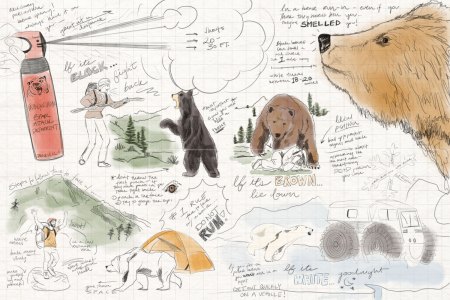After an attack from a group of drunken men left him for dead and rendered him disillusioned, Ken Smith quit his job and spent years traveling and honing his survival skills in the Yukon. Finished with the wilderness of northwestern Canada, Smith continued his nomadic lifestyle in Britain before settling in the Scottish Highlands as the “Hermit of Loch Treig.” The subject of a film of the same name, Smith is the author of a new book that was released earlier this week.
Written with Will Millard, The Way of the Hermit: My Incredible 40 Years Living in the Wilderness shares Smith’s reflections about why he turned his back on society, the way vulnerability increases as we age and how living a life in nature can create a sense of awe — and sometimes terror. In the following excerpt from The Way of the Hermit, Smith recounts a tale having to do with the latter entitled “My Very Best Near-Death Bear Story.” (Should you ever find yourself in a situation similar to Smith’s, here’s what to do.)
It happened while I was stopping at Whitehorse, the capital of the Yukon, and I was indulging in one of my favorite money-spinning escapades. I was down at the local rubbish dump looking for useful things that people have thrown out. Anything that could help me in any way. You would not believe what gets thrown away down there. Humans are incredibly wasteful, but, as the old northern saying goes, “Where there’s muck, there’s brass.”
Over many years of dump-diving, I’ve found clothing (including brand-new boots), in-date cans of food, pots and pans, full batteries, and loads of electronics; I’ve even found money. Industrious people with flatbed trucks would be backing in and out of those places all the time, lifting kitchen appliances, old motors, wiring, whole carpets, and then making simple repairs, or giving them a clean before selling them, almost good as new.
This particular dump was enormous. A large twelve-foot-high fence spanned the perimeter, while bulldozers and diggers moved around inside, managing mountains of rubbish that were so high they towered over you and frequently blocked out the sunlight.
The trick for a good haul was to head for areas that had been freshly dug or piled by the diggers: either the mountains of newly turned treasures, or the craters left behind in the waste. That fateful day I was deep in the dump, walking up a hill of rubbish to get to an area where a new pile had just been created. I was strolling along a plateau, and couldn’t have been too far from my destination, when a movement to the left of my makeshift path stopped me dead in my tracks.
My heart rate danced as my focus was pulled towards the source of the movement. I could see immense bulk, and brown fur moving backwards. This was not a trick of the light, a cuddly toy, or a hallucination brought on from the stench of the dump. What I was looking at was the giant arse of a simply enormous grizzly bear as it reversed its way backwards out of the hole it had just created in the garbage.
Clearly, it had been looking for food and, judging by the look on its face, it had been unsuccessful. I stood motionless, not due to my superior knowledge of staving off death by bear, but because I was quite simply stupefied by terror.
We were face-to-face on the same pathway, and now the grizzly was slowly, but very purposefully, advancing towards me. Clearly, I was in very deep trouble indeed. I was hemmed in by the dump’s fence on all sides and, at twelve feet high, as much as it might seem theoretically possible for me to scale the barrier without being eaten, I could only make it there if I could first negotiate my way around the labyrinth formed by all the dump’s rubbish.

If the bear didn’t catch me before I got to the fence, which seemed highly likely, it would almost certainly catch me as I tried to scramble over. This fully grown grizzly stretched some eight feet in height from its feet to its claw-tips. It would pluck me off and crunch me as easily as I’d pinch an apple from a tree.
It left me with just one credible option for escape. I needed to go right back the way I’d come. Back along the plateau atop the rubbish mountain, then down the pathway till I made it to the sole entrance and exit: the main gate in the fence. It seemed an almightily long way away right then, but, through the fog of catatonic fear I knew, no matter what I did, I could not make a run for it.
The bear might have been moving on me with serious intent, but it wasn’t charging me. Not yet, anyway. Given a grizzly can sprint at up to thirty-five miles per hour when it wants to, the best chance I had was if the bear maintained its measured plod. This was obviously no grizzly defending her cubs. This was the far rarer example of a grizzly actively engaged in stalking a human. If it made it to me, which it absolutely was going to if I remained still, “playing dead” would quickly result in performance art becoming dreadful reality.
In terms of human-bear interactions, this was the most dangerous position you could possibly be in, with the absolute worst brand of bear: a giant adult grizzly that held no fear of humans and was very hungry.
With the gap closing between me and the bear, I slowly started to pace backwards. Remaining calm in my body language, making no rapid movements, and giving no reason for the bear to bolt forward, while very deliberately moving away and keeping my eyes fixed upon the animal. Luckily, as I began to move, the bear’s pace did not quicken, and we entered a curious dance where we maintained a distance between us by matching pace: me backwards, the bear forwards. I just had to hope I didn’t trip over on some lump of trash, otherwise I was definitely history.
It is a curious experience, being confronted with your total physical vulnerability. Our lifestyle, our technology, our houses and cars all shield us from our actual, feeble reality. They create a reassuring gap between now and the time in the past when we all lived in caves and trees. Back in prehistory, the specter of a very violent death at the hands of a saber-tooth, cave hyena, or short-faced bear was omnipresent; but today, most humans, and especially those who live in the Western world, can easily go their entire lives without ever realizing quite how fragile and feeble we really are, especially when held up against the apex predators of the wider natural world.
How to Escape a Bear
Large-carnivore ecologist Dr. Rae Wynn-Grant on avoiding “Revenant”-style encounters in the wildIt was highly ironic that, trapped within this colossal mountain of human engineering, the visual metaphor for all our “progress,” there was not one single thing at hand that could’ve staved off the murderous advances of this bear. Most of the waste I walked within had been created purely for our living convenience, improving our lives on the one hand, whilst degrading the planet’s habitats and condemning this bear to hunt the dump for food on the other. I was in a truly pitiful position. A highly intelligent tortoise who had forgotten to put on his shell.
Walking backwards, I made it across the plateau and became aware that I was heading back down the slope. That was my eureka moment. If I maintained the gap now, there would soon be a very brief moment where the bear would disappear from view over the brow of the hill; the only time in my retreat where I wouldn’t be able to see the bear and, crucially, it wouldn’t be able to see me either.
I stared back at the bear as I paced down. “Can’t see its ankles now,” I muttered to myself. “Can’t see its legs now,” I continued. “Can’t see its belly…can’t see its head.”
And in that moment, I broke the golden rule of grizzly attack and ran as fast as I ever have in my entire life. In Derbyshire parlance, I ran like absolute buggery — straight back through the gate and down onto the road outside the dump. There, I met a V-shaped junction cutting around a small wood but, filled with adrenaline and panic, and certain the bear’s breath was hot on my heels, I didn’t even deviate from my course. Instead, I ran straight through the wood, straight out the other side, and almost got flattened by a truck.
The man slammed on his brakes and exploded at me in a rage of brake pad fumes and dust. “There’s a grizzly inside!” I screamed back at him. “GRIZZLY BEAR!” he shouted back, his countenance doing an instant about-turn as he quickly reached down the back of his seat for his gun.
This man was armed and ready in a way that suggested he might’ve been waiting for this moment his entire life. With one hand on the steering wheel, and another on the trigger of a rifle that looked capable of dispatching a T. rex, he blasted his truck all the way to the front gate and ran inside.
I was safely back in the human world of faux superiority through working technology, but I didn’t hear a rifle shot and the bear had already escaped. I’d been very lucky and so had the bear. The municipal rubbish dump was no place to die for either of us.
This article was featured in the InsideHook newsletter. Sign up now.

























